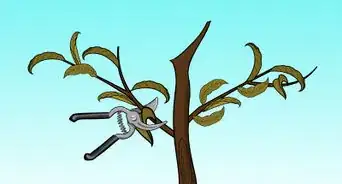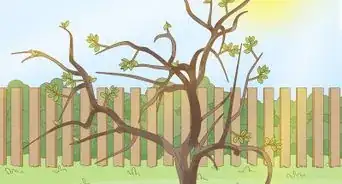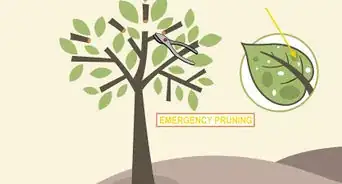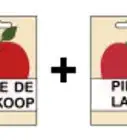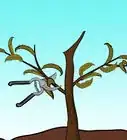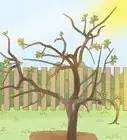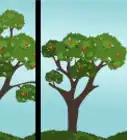This article was co-authored by Andrew Carberry, MPH and by wikiHow staff writer, Luke Smith, MFA. Andrew Carberry is a Food Systems Expert and the Senior Program Associate at the Wallace Centere at Winrock International in Little Rock, Arkansas. He has worked in food systems since 2008 and has experience working on farm-to-school projects, food safety programs, and working with local and state coalitions in Arkansas. He is a graduate of the College of William and Mary and holds a Masters degree in public health and nutrition from the University of Tennessee.
There are 7 references cited in this article, which can be found at the bottom of the page.
wikiHow marks an article as reader-approved once it receives enough positive feedback. This article has 31 testimonials from our readers, earning it our reader-approved status.
This article has been viewed 929,703 times.
Growing apples at home can be a rewarding experience, both in the process and the results. If you've been cultivating an apple tree and want to get maximum fruit production out of it, you'll need to get pruning! Pruning works to create a healthier tree, stimulate growth, and produce larger quantities and higher quality fruit over time. We’ll prime you on the proper timing and the tools you need, then show you how to prune both young and mature apple trees to get the most out of your harvest.
Things You Should Know
- Prune your trees in March or April to avoid damaging branches or impeding growth.
- Shape young trees into pyramids, with 4-6 thick, primary branches emerging from the trunk.
- Routinely cut away dead or damaged wood, as well as any branches growing vertically or downward.
- Thin out the fruiting buds so that they’re about 6 in (15 cm) apart, and only contain 1 fruit per bud.
Steps
Timing and Tools
-
1Prune in late winter or early spring. Get clipping after the last frost, but before your tree starts sprouting new growth (about March through April, in most places where apple trees grow).[1] Trimming too early might weaken your tree during the coldest months. Pruning too late might damage it when it’s trying hardest to grow.[2]
- If you miss this window, perform a light prune in late July or August.
- Avoid pruning in the fall, since any new growth will die off come winter.
-
2Use pruning shears for small cuts, and a garden saw for large cuts. For limbs smaller than about 1 in (2.5 cm) in diameter, use hand pruners. Use lopping shears for branches that are about 1–3 in (2.5–7.6 cm). Use a pruning saw to cut any branches wider than 3 in (7.6 cm).[3]
- Using a tool that’s too small for the job can damage the branch. Using one that’s too large might result in clumsy, improper cuts.
- Before and after pruning, disinfect your garden tools with isopropyl alcohol to prevent spreading diseases to the tree.
Advertisement -
3Prune young trees to shape them, and older trees to encourage fruiting. Trees younger than 3 years aren’t in their prime fruiting days, so prune them more heavily to encourage strong structure. Trim mature trees sparingly to make sure their energy goes into producing fruit, rather than upward growth.[4]
- Generally, apple trees shouldn’t be great shade trees. If you would comfortably sit under your apple tree to shelter from the sun, it’s time to prune!
Training a Young Tree
-
1Shape your tree into a cone to encourage healthy growth. As you cut, aim for a pyramidal shape, with a narrow top and a wide base. This shape allows for sunlight to fall evenly through the canopy. It also promotes stronger, healthier limbs and generous fruiting.[5]
-
2Lop off any competing leading branches. The leading branches are the center, vertical branches that emerge from the trunk. Generally, an apple tree should only have a single, stocky leading branch to pioneer upward growth. If this branch forks, select the fork that’s thickest and most upright, and cut away the other.[6]
-
3Preserve 4-6 primary scaffold branches for the best structure. Scaffold branches are the thick, primary branches that jut from the center leading branch. Typically, a well-pruned apple tree has 4-6 scaffold branches, which grow in 2-3 tiers. Select 3-4 well-spaced (about 10 in (25 cm) apart), strong scaffold branches in your young tree, and cut the rest off at the base.[7]
- Opt for scaffold branches growing at 45- to 60-degree angles from the trunk to encourage outward growth.
- Let the tree grow 2-3 new scaffold branches each year until maturity, maxing out at 6 total scaffold branches after about 5 years.
- Seen from an aerial view, the scaffold branches of the tree will ideally look similar to a star or the spokes on a wheel.
Pruning a Mature Tree
-
1Prune off any shoots growing from the base of the tree. Suckers are the unwanted shoots that grow near the bottom of the trunk.[8] Remove all of these shoots up to the base of the main canopy of the tree to encourage a good shape.[9]
- Suckers aren’t much good for growing fruit. If unchecked, they’ll crowd out other limbs and use up valuable energy.
-
2Cut off any broken, dead, or diseased wood. If a branch is withered, discolored, or has snapped under any sort of stress, go ahead and lop it off. Remove the entire branch if it doesn't have any buds. If it does have buds towards the base of the branch, make a cut just above the last healthy bud on the branch. Remove these branches at any time of year, as soon as you notice them[10]
- When cutting branches with buds, cut at an angle about 0.25 in (0.64 cm) above a bud that faces away from the trunk of the tree. This encourages healthy, new growth.
-
3Cut off any watersprouts and downward-growing branches. Prune away and branches growing downward, since these won’t be able to bear significant fruit. In addition, trim away any sprouts growing straight up from the branches (known as “watersprouts”), which divert energy from fruit-bearing limbs.[11]
- Cutting away entire branches in this manner is known as “thinning.”
-
4Prune down crowded branch nodes. “Whorls” are locations in which 3 or more small branches originate from the same location, and are especially common in more mature trees. Because so many limbs are growing from the same place, the branch is weaker and unable to support the branches as they grow. Cut away all but the thickest, strongest shoot.[12]
- Also cut away the smaller branches in any areas where branches are touching or overlapping.
-
5Shorten the remaining branches. Cut back the rest of the branches by about 1/3 of their length to encourage the stems to thicken and develop flowers the following season. Make each cut just above an outward facing bud to encourage a healthy shape.[13]
-
6Pluck young fruits to thin out the clusters. Apple trees tend to grow more fruit than they can reasonably produce. Once your tree is fruiting, remove young fruits by hand, so that there’s only 1 fruit per cluster of buds. Also remove fruits so that each is about 6 in (15 cm) away from the next fruit on the branch.[14]
- This helps the tree grow large, healthy apples, rather than an abundance of smaller, less preferable fruit.
Expert Q&A
-
QuestionMy golden delicious tree has a lot of straight upward branches. Should they be removed?
 Andrew Carberry, MPHAndrew Carberry is a Food Systems Expert and the Senior Program Associate at the Wallace Centere at Winrock International in Little Rock, Arkansas. He has worked in food systems since 2008 and has experience working on farm-to-school projects, food safety programs, and working with local and state coalitions in Arkansas. He is a graduate of the College of William and Mary and holds a Masters degree in public health and nutrition from the University of Tennessee.
Andrew Carberry, MPHAndrew Carberry is a Food Systems Expert and the Senior Program Associate at the Wallace Centere at Winrock International in Little Rock, Arkansas. He has worked in food systems since 2008 and has experience working on farm-to-school projects, food safety programs, and working with local and state coalitions in Arkansas. He is a graduate of the College of William and Mary and holds a Masters degree in public health and nutrition from the University of Tennessee.
Food Systems Expert Yes, you should remove them. Try to leave branches with a 45 to 50 degree angle from the trunk.
Yes, you should remove them. Try to leave branches with a 45 to 50 degree angle from the trunk. -
QuestionMy apple tree is eight years old and has never been pruned. It has not produced any fruit in the last two years. How do I prune it to correct this?
 Andrew Carberry, MPHAndrew Carberry is a Food Systems Expert and the Senior Program Associate at the Wallace Centere at Winrock International in Little Rock, Arkansas. He has worked in food systems since 2008 and has experience working on farm-to-school projects, food safety programs, and working with local and state coalitions in Arkansas. He is a graduate of the College of William and Mary and holds a Masters degree in public health and nutrition from the University of Tennessee.
Andrew Carberry, MPHAndrew Carberry is a Food Systems Expert and the Senior Program Associate at the Wallace Centere at Winrock International in Little Rock, Arkansas. He has worked in food systems since 2008 and has experience working on farm-to-school projects, food safety programs, and working with local and state coalitions in Arkansas. He is a graduate of the College of William and Mary and holds a Masters degree in public health and nutrition from the University of Tennessee.
Food Systems Expert Start by removing all dead, damaged, or diseased wood the first year. This will likely stimulate new growth and fruiting. You can prune for shape the 2nd year, but don't remove more than 1/3 of the volume of the tree at a time.
Start by removing all dead, damaged, or diseased wood the first year. This will likely stimulate new growth and fruiting. You can prune for shape the 2nd year, but don't remove more than 1/3 of the volume of the tree at a time. -
QuestionMy apple tree has gotten very tall. Can I cut the top off?
 wikiHow Staff EditorThis answer was written by one of our trained team of researchers who validated it for accuracy and comprehensiveness.
wikiHow Staff EditorThis answer was written by one of our trained team of researchers who validated it for accuracy and comprehensiveness.
Staff Answer wikiHow Staff EditorStaff AnswerYes, you may cut off the top, leading branch to control the size. Cut it to the next lowest branch.
wikiHow Staff EditorStaff AnswerYes, you may cut off the top, leading branch to control the size. Cut it to the next lowest branch.
References
- ↑ http://chemung.cce.cornell.edu/resources/pruning-apple-trees
- ↑ https://extension.umaine.edu/fruit/growing-fruit-trees-in-maine/pruning/
- ↑ https://extensionpublications.unl.edu/assets/pdf/ec1233.pdf
- ↑ https://extension.oregonstate.edu/news/apple-trees-benefit-proper-pruning-spring-summer
- ↑ https://extension.psu.edu/pruning-apples-and-pears-in-home-fruit-plantings
- ↑ https://extension.psu.edu/pruning-apples-and-pears-in-home-fruit-plantings
- ↑ https://extensionpublications.unl.edu/assets/pdf/ec1233.pdf
- ↑ https://extensionpublications.unl.edu/assets/pdf/ec1233.pdf
- ↑ http://cesonoma.ucanr.edu/files/27164.pdf
- ↑ https://extension.umaine.edu/fruit/growing-fruit-trees-in-maine/pruning/
- ↑ https://extensionpublications.unl.edu/assets/pdf/ec1233.pdf
- ↑ https://hgic.clemson.edu/factsheet/pruning-training-apple-pear-trees/
- ↑ https://extensionpublications.unl.edu/assets/pdf/ec1233.pdf
- ↑ https://hgic.clemson.edu/factsheet/pruning-training-apple-pear-trees/
About This Article
To prune apple trees, wait until spring and early summer. Then, use hand pruners and loppers to cut off any downward growing branches or branches that are dead or diseased. You should also prune any suckers that are growing at the base of the apple tree. As you prune, try to maintain a slightly conical shape so the tree is thicker at the base and thinner at the top. Once you've pruned all of the unwanted branches, cut the rest of the branches back one-third of their length, which will help them thicken and grow more flowers. For more information from our Food Systems Expert co-author about how to detect diseased branches, keep reading!
